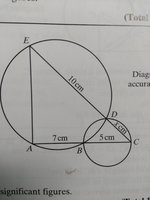bumblebee123
Junior Member
- Joined
- Jan 3, 2018
- Messages
- 200
question:
the diagram shows two circles. A,B,D and E are points on one circle. B,C and D are points on the second circle. BC is a diameter of the second circle. ABC and CDE are straight lines
a) show that angle BAE = 90 degrees You must give a reason for each stage in your working
AB = 7cm, BC = 5cm, DE = 10cm and CD= x cm
b) (i) show that x^2 + 10x - 60 = 0
(ii) calculate the length of CE. give your answer to 3.s.f.

I have no idea where to start- any help would be really appreciated!
the diagram shows two circles. A,B,D and E are points on one circle. B,C and D are points on the second circle. BC is a diameter of the second circle. ABC and CDE are straight lines
a) show that angle BAE = 90 degrees You must give a reason for each stage in your working
AB = 7cm, BC = 5cm, DE = 10cm and CD= x cm
b) (i) show that x^2 + 10x - 60 = 0
(ii) calculate the length of CE. give your answer to 3.s.f.

I have no idea where to start- any help would be really appreciated!

